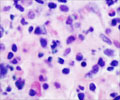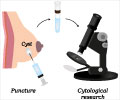A recent study introduces methods for detecting preeclampsia risk through with potential benefits for early intervention in pregnancy complications.

‘Liquid biopsy reveals promising potential for early preeclampsia detection through DNA methylation profiling, offering hope for improved maternal and fetal health’





Advertisement
Preeclampsia and its Complications
Preeclampsia is a potentially serious medical condition that can occur during pregnancy or after childbirth .Preeclampsia typically develops after the 20th week of pregnancy and can affect both the mother and the developing baby (1✔ ✔Trusted SourceBlood biomarkers to predict the onset of pre-eclampsia: A systematic review and meta-analysis
Go to source). Common symptoms of preeclampsia may include headaches, visual disturbances (such as blurred vision or seeing spots), swelling of the hands and face, and abdominal pain and other complications such as,
High Blood Pressure:
Hypertension during pregnancy can be dangerous because it can reduce blood flow to the placenta, which can deprive the baby of oxygen and nutrientsProteinuria:
Another hallmark of preeclampsia is the presence of excess protein in the urine (proteinuria). This is a sign that the kidneys are not functioning properlyOrgan Damage:
Preeclampsia can lead to damage in various organs, including the liver, kidneys, brain, and blood-clotting system. Severe cases can result in organ failureEclampsia:
Eclampsia, is known as seizures. Eclampsia is a life-threatening complication of preeclampsia and requires immediate medical attention
Advertisement
Preeclampsia is a Public Health Challenge
Preeclampsia is a relatively common pregnancy complication, affecting about 5-8% of pregnancies worldwide. Preeclampsia can have serious consequences for both the mother and the baby. If left untreated, it can lead to complications such as stroke, organ failure, preterm birth, low birth weight, and stillbirth.The only effective treatment for preeclampsia is the delivery of the baby and the placenta, which may not be ideal if the pregnancy is at an early stage. Women who have had preeclampsia have an increased risk of developing cardiovascular disease and hypertension later in life, highlighting the importance of long-term monitoring and care.
There are no definitive tests to predict who will develop preeclampsia, and the exact cause of the condition is not fully understood. This makes early detection and prevention challenging.
DNA-methylation Biomarker Detects Preeclampsia in Early Stages
Early identification of this condition is imperative for initiating disease intervention. Liquid biopsy, an emerging and promising diagnostic tool for non-invasive assessments, is increasingly being employed for disease detection, monitoring progression, and evaluating treatment responses.In this study, Bernard Thienpont and colleagues from the Department of Human Genetics at KU Leuven in Leuven, Belgium, analyzed blood DNA-methylation data obtained from 498 pregnant women, approximately one-third of whom ultimately developed preeclampsia.
The researchers identified variations in DNA methylation between pregnancies that proceeded normally and those that resulted in preeclampsia. Leveraging this data, they devised a model capable of stratifying risk not only at the time of preeclampsia diagnosis but also in the presymptomatic phase, around the 12th week of gestation.
In an additional analysis encompassing 197 of these women, they demonstrated that this model, when combined with clinical and demographic risk factors, yielded a risk score that accurately predicted 72% of individuals who would later experience early-onset preeclampsia.
It notes that while the authors validated the screening tool across various populations, their approach employed a case-control design in all cases. This methodology could artificially inflate the relative proportions of pre-eclampsia cases, exceeding what is typically observed in the general population (as preterm preeclampsia typically has only a 1% incidence rate).
In conclusion, To address the public health challenge posed by preeclampsia, healthcare systems and researchers focus on improving early detection. The preliminary findings of this study indicate that the profiling of cell-free DNA methylation holds promise as a tool for assessing the risk of pre-eclampsia before symptoms emerge.
Regular prenatal care and monitoring are crucial to identifying and managing this condition, as early intervention can greatly improve outcomes for both mothers and babies.This approach has the potential to enhance the management and follow-up of patients in the field of obstetrics.
Reference:
- Blood biomarkers to predict the onset of pre-eclampsia: A systematic review and meta-analysis - (https://pubmed.ncbi.nlm.nih.gov/36387521/)
Source-Medindia















